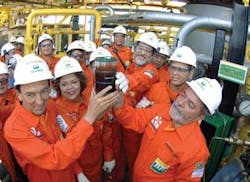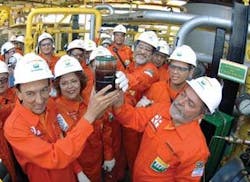Jubarte field opens Petrobras’ pre-salt production
Peter Howard Wertheim - Contributing Editor
A milestone for the Brazilian oil industry, first production from pre-salt layer, kicked-off this past Sept. 2 in Jubarte field, north of Campos basin, in 1,323 m (4,341 ft) water depth, some 77 km (48 mi) off the southern coast of Espírito Santo state on BC-60 block.
While holding up a small barrel with the first oil produced from the Jubarte pre-salt reservoir, José Sergio Gabrielli, Petrobras’ president, said: “This is an extraordinary day, the beginning of a new era, an important moment for the country and for the company’s position in the international oil market.”
Petrobras was able to place the first well in the pre-salt layer into production less than two years after the reservoir was discovered. For Gabrielli, “the first pre-salt oil in the Jubarte field will leverage the development of the other pre-salt layer wells the company has in Espirito Santo, Campos, and Santos basin. This well will teach us what to do in Tupi, Jupiter, and Carioca.”
Governmental authorities were celebrating the beginning of a Long-Duration Test (LDT) with production of 10,000 b/d of 28º API light oil and 500,000 cm/d (17.7 MMcf/d) of associated gas.
The fact that Petrobras already was producing 36,000 b/d of 17º API heavy oil from reserves estimated at 600 MMboe in the post-salt layer in Jubarte field allowed production in the pre-salt layer in Espírito Santo to be anticipated, says Petrobras.
The FPSOP-34 is moored 2.5 km (1.55 mi) from the 1-ESS-103A exploratory well, which discovered the oil in the pre-salt. Thus, most of the needed infrastructure already was in place and the distance from reservoirs to the coast is shorter than those of the pre-salt reservoirs in Santos basin.
The LDT for light oil that started in September is expected to last six months to a year, enough for the company to observe how pre-salt oil behaves, both in the reservoir and in the platform’s process plant.
As a result of research about the formation of the South American and African continents by Petrobras geologists, more than $1.5 billion was invested by Petrobras in the past couple of years to drill 15 wells that reached the pre-salt formation with 100% success in finding oil.
Eight wells have been tested and revealed quantities of light oil and large amounts of associated natural gas but have not been declared commercial because they are still under assessment.
According to Guilherme Estrella, Petrobras E&P director, the lake that formed during the beginning of the separation of the continents some 120 million years ago allowed the deposition of source rocks (Lagoa Feia formation) that originated the reserves now starting to be produced in the southern Atlantic Ocean.
The difficulty is to prove how much petroleum is being held by the salt layer, which is an excellent sealer. However, data to date indicate with a high degree of safety that a prolific formation covers an area that ranges 800 km (497 mi) in length from Espírito Santo to southernmost Santa Catarina state, and some 200 km (124 mi) width, in water depths of 1,000 to 3,000 m (3,281 to 9,842 ft).
In Jubarte pre-salt reservoir, Petrobras found the same characteristics that mark the huge formation known as the pre-salt cluster offshore Brazil: microbiolite, a calcium carbonate of the same kind found in Tupi and other fields at Santos basin. Well 1–ESS-103, where Petrobras inaugurated pre-salt production was drilled vertically, when normally, pre-salt wells are drilled horizontally, adds Estrella.
Heavy oil reservoir
In January 2001, Petrobras announced the discovery of a reservoir in Jubarte, above the salt layer, in well 1-ESS-100, BC-60 block.
After that, the company notified the National Petroleum Agency (ANP) of another 42 discoveries with traces of oil and some gas in the same block.
Of these, three notifications came in August, October and most recently Nov. 14 with traces of oil and gas in 1,348 m (4,423 ft) water depth.
In June 2002, Petrobras was authorized to perform the post-salt LDT in heavy oil well 1–ESS-110 to collect data for the development project and in October 2002 the FPSOSeillean started the tests. Jubarte was declared commercial on Dec. 11 of that year, but oil production continued flowing a 20,000 b/d average until January 2006.
Jubarte field post-salt development project comprises of two phases. The first one started in December 2006 consisting of four production wells connected to a vessel christened in homage to former president Juscelino Kubitschek, the FPSOJK (P-34) that has capacity to process 60,000 b/d.
TheP-34, moored in 1,350 m (4,429 ft) water depth was adapted to produce the heavy oil found in the reservoir above the salt, and to store and transfer the oil to offloading ships. The FPSO is 230 m (755 ft) long, 26 m (85 ft) wide and 17 m (56 ft) high.
It has one of the largest turrets in the world and through it passes the electric power cables that feed two 1,200 hp electric submersible pumps installed at the well to lift the heavy oil. These cables use a free rotating spool (SDW), patented by Petrobras rather than using an electric swivel.
Phase 2, scheduled for 2011, will be developed by FPSOP-57 with capacity to process 180,000 b/d of oil and compress 2 MMcm/d (70.6 MMcf/d) of gas, and will comprise 15 production wells and seven injection wells.
A $1.2-billion contract to buildP-57 was signed with Single Buoy Moorings as part of Petrobras’ 2015 strategic plan to reach production of 3.455 MMboe/d.
Forecasted minimum national content in the construction is of 65%, excluding the acquisition of the larger machinery and the hull conversion, which will take place in Singapore. Most of the modules and the integration between the modules and the hull of the vessel will take place in the Brasfels shipyard, at Angra dos Reis, Rio de Janeiro.
For the conversion, the contracted company will supply the oil tankerIsland Accord. At the end of the construction, SBM will operate P-57 for three years for $63.55 million.
Adjustment for light oil
In order to adjust theP-34 to the characteristics of the light 30° API, pre-salt oil found in Jubarte, it was necessary to make several adaptations to the platform’s processing plant.
Including the completion of well 1-ESS-103A and its interconnection toP-34 investments totaled some $50 million, say Petrobras officials.
The project turned the FPSO into a showcase of Petrobras’ innovations including a new artificial lifting technology, a special installation setting for a submersible subsea centrifugal pump, and an efficient fluid separation system (oil/water) during production.
Petrobras’ research and development center also reserved a test site on the deck to apply new technologies being developed at its headquarters in Rio de Janeiro.
When asked about volumes of light oil found in pre-salt reservoirs, Petrobras said it estimates recoverable oil in the Santos basin’s Tupi field at 5-8 Bbbl and Iara field at 3-4 Bbbl, both in the BM-S-11 block.
Currently, besides the test in Jubarte, Petrobras is undertaking LDT in well 6-BAZ-1DB-ESS in Baleia Azul field and is drilling well 6-BFR-1- ESS, in Baleia Franca field, both aim to reach the pre-salt layer. Only after concluding the evaluation process the company will announce additional reserves estimates.
The production of gas originating from these fields will be transported onshore through an 80-km (50-mi) long pipeline to the gas treatment unit Sul Capixaba. The unit will be linked to Gasene, the southernmost gas distribution system being built by Petrobras. The gas treatment unit is expected to begin operating in the first half of 2010.
Within a short time, many discoveries took place near Jubarte field, named after a type of whale that comes from the South Pole into the warmer waters of the Atlantic. The Cachalote field named after another type of whale was discovered in 2002, followed by Baleia Franca, Baleia Anã and Baleia Azul fields in 2004. These fields, plus Cacharéu and Pirambu fields, discovered in 2006, form what is known as the prolific as well as environmentally sensitive “Whale Park.”


